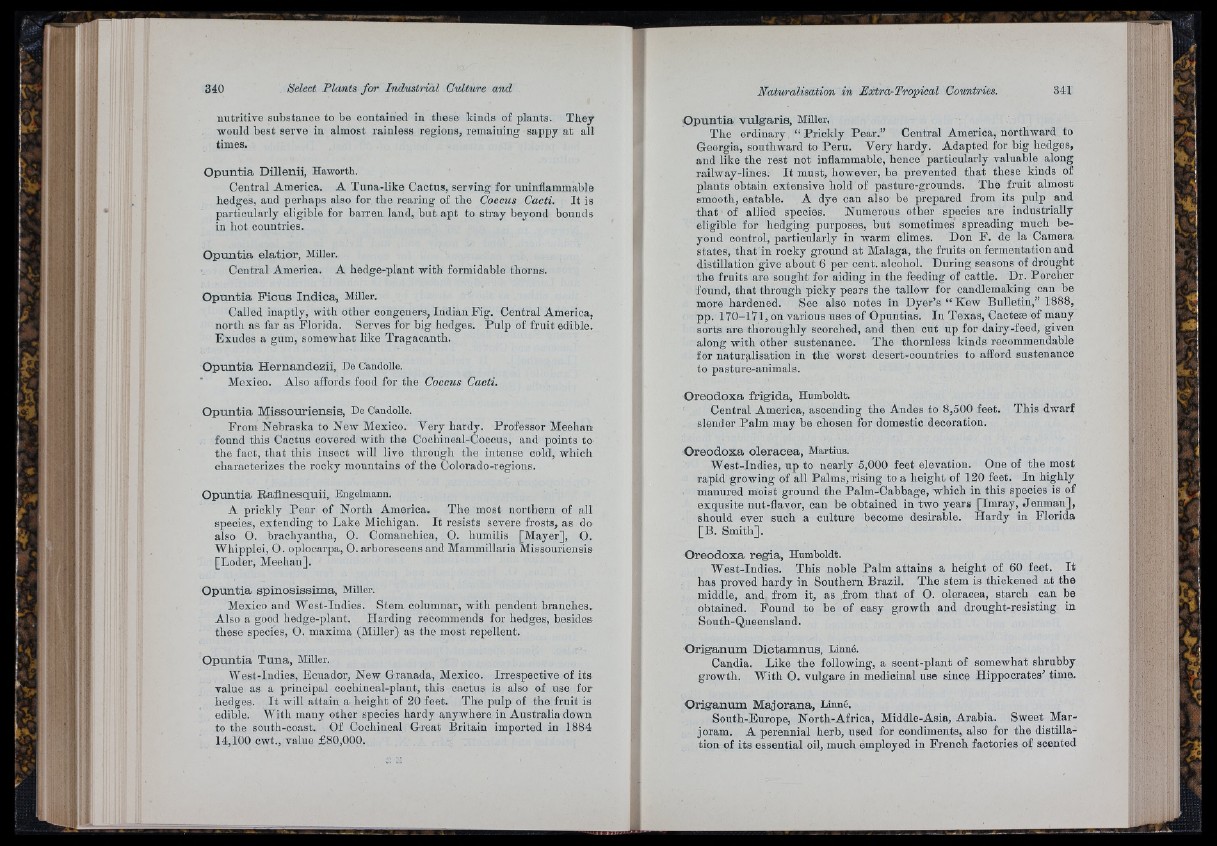
nutritive substance to be contained in tliese kinds of plants. They
would best serve in almost rainless regions, remaining sappy at all
times.
Opuntia Dillenii, Haworth.
Central America. A Tuna-like Cactus, serving for uninflammable
hedges, and perhaps also for the rearing of the Coccus Cacti. I t is
particularly eligible for barren land, but apt to stray beyond bounds
in hot countries.
Opuntia elatior, Miller.
Central America. A hedge-plant with formidable thorns.
Opuntia Ficus Indica, Miller.
Called inaptly, with other congeners, Indian Fig. Central America,
north as far as Florida. Serves for big hedges. Pulp of fruit edible.
Exudes a gum, somewhat like Tragacanth.
Opuntia Hernandezii, De Candolle.
Mexico. Also aifords food for the Coccus Cacti.
Opuntia Missouriensis, De Candolle.
From Nebraska to New Mexico. Very hardy. Professor Meehan
found this Cactus covered with the Cochineal-Cocous, and points to
the fact, that this insect will live through the intense cold, which
characterizes the rocky mountains of the Colorado-regious.
Opuntia Baflnesquii, Engelmann.
A prickly Pear of North America. The most northern of all
species, extending to Lake Michigan. I t resists severe frosts, as do
also O. hrachyautha, O. Comanchica, O. humilis [Mayer], O.
Whipplei, O. oplocarpa, O. arborescens and Mammilla! ia Missouriensis
[Loder, Meehan].
Opuntia spinosissima, Miller.
Mexico and West-Indies. Stem columnar, with pendent branches.
Also a good hedge-plant. Harding recommends for hedges, besides
these species, O. maxima (Miller) as the most repellent.
Opuntia Tuna, Miller.
West-Iudies, Ecuador, New Granada, Mexico. Irrespective of its
value as a principal cochineal-plant, this cactus is also of use for
hedges. I t will attain a height of 20 feet. The pulp of the fruit is
edible. With many other species hardy anywhere in Australia down
to the south-coast. Of Cochineal Great Britain imported in 1884
14,100 cwt., value £80,000.
Opuntia vulgaris, Miller,
The ordinary “ Prickly Pear.” Central America, northward to
Georgia, southward to Peru. Very hardy. Adapted for big hedges,
and like the rest not inflammable, hence particularly valuable along
railway-lines. I t must, however, be prevented th a t these kinds of
plants obtain extensive hold of pasture-grounds. The fruit almost
smootli, eatable. A dye can also be prepared from its pulp and
th a t of allied species. Numerous other species are industrially
eligible for hedging purposes, but sometimes spreading much beyond
control, particularly in warm climes. Don F . de la Camera
states, th a t in rocky ground a t Malaga, the fruits on fermentation and
distillation give about 6 per cent, alcohol. During seasons of drought
the fruits are sought for aiding in the feeding of cattle. Dr. Porcher
found, th a t through picky pears the tallow for candlemaking can be
more hardened. See also notes in Dyer’s “ Kew Bulletin,” 1888,
pp. 170-171, on various uses of Opuntias. In Texas, Cacteæ of many
sorts are thoroughly scorched, and then cut up for dairy-feed, given
along with other sustenance. The thornless kinds reeommendable
for naturalisation in the worst desert-countries to afford sustenance
to pasture-animals.
Oreodoxa frigida, Humboldt.
Central America, ascending the Andes to 8,500 feet,
slender Palm may be chosen for domestic decoration.
This dwarf
Oreodoxa olerácea, Martius.
West-Indies, up to nearly 5,000 feet elevation. One of the most
rapid growing of all Palms, rising to a height of 120 feet. In highly
manured moist ground the Palm-Cahbage, which in this species is of
exqusite nut-flavor, can be obtained in two year» [Imray, Jenman],
should ever such a culture become desirable. Hardy in Florida
[B. Smith].
Oreodoxa regia, Humboldt.
West-Indies. This noble Palm attains a height of 60 feet. I t
has proved hardy in Southern Brazil. The stem is thickened at the
middle, and from it, as .from th a t of O. oleraoea, starch can be
obtained. Found to be of easy growth and drought-resisting in
South-Queensland.
Origanum Dictamnus, Linné.
Candia. Like the following, a scent-plant of somewhat shrubby
growth. With O. vulgare in medicinal use since Hippocrates’ time.
Origanum Majorana, Linné.
South-Europe, North-Africa, Middle-Asia, Arabia. Sweet Marjoram.
A perennial herb, used for condiments, also for the distillation
of its essential oil, much employed in French factories of scented